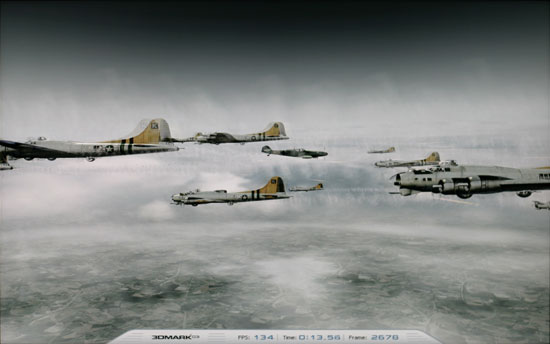Response Times
A topic that usually comes up as a problem with LCDs is their slower response times relative to CRTs. While there's no doubt that even the best LCDs still exhibit some slight pixel smearing, the vast majority of users are okay with the level of performance we have available now. We also find it extremely difficult to tell the difference between various LCDs with response times ranging from as low as 2ms all the way up to 16ms. As with other specifications, there appears to be marketing influence on the final reported numbers.
To try to illustrate response times, we use our camera set to 1/80s shutter speed and a 2.5 F-stop at ISO-400. However, taking a picture of a display using a high shutter speed still isn't the same as looking at the display in person. LCDs run at a refresh rate of 60 Hz, and we use a shutter speed of 1/80s, so the net result is that we will capture an image of the display as it appears over a short period as opposed to an instantaneous look at the state of the various pixels. Image retention on your retinas also occurs, so even if you can eliminate the smearing effect at the display level you won't necessarily "see" a perfectly crisp transition. Then you have to consider some of the latest games are adding motion blur back in using DirectX 9/10 in order to make things look more realistic... but in that case, it's an artistic effect rather than a technological defect, right?
Links to previous response time images are below, taken during the Game 1 demo in 3DMark03.
Acer AL2216W #1 Acer AL2216W #2
Dell 2405FPW #1 Dell 2405FPW #2
Dell 2707WFP #1 Dell 2707WFP #2
Dell 3007WFP #1 Dell 3007WFP #2
Gateway FPD2485W
HP LP3065 #1 HP LP3065 #2
HP w2207
HP w2408
 MPA Off |
 MPA On |
Samsung advertises a 5 ms gray-to-gray (GTG) response time, although it's not entirely clear whether that figure is with MPA enabled or disabled. We tested response times and configurations, and we would be hard-pressed to tell the difference. In our best-case images, the 245T does appear to have slightly better response times than other 24" LCDs that we've reviewed, but the actual difference is probably less than a couple milliseconds. We're not sure about the rest of you, but our eyes just aren't sensitive enough to tell the difference between 6/1000s and 8/1000s, even if the first is theoretically 33% less time.










60 Comments
View All Comments
Owls - Thursday, February 7, 2008 - link
I agree. The ads are highly instrusive. Any other sites people recommend?GNStudios - Thursday, February 7, 2008 - link
I read the review and got very intrested in the monitor (I have a Samsung 215TW now). When browsing some the internet I found many people complaining that it's very noisy.Is this true?
mattsaccount - Thursday, February 7, 2008 - link
My parents bought one of these over Christmas. The monitor they received definitely emits a certain amount of noise, but none of us found it that distracting. You can barely hear it in normal use, and it's not an irritating high pitch ring or anything.JarredWalton - Thursday, February 7, 2008 - link
I haven't noticed any noise from this particular unit, but that's pretty variable. Usually the noise comes from capacitors inside the chassis, so as best as I can tell it's luck of the draw.kmmatney - Thursday, February 7, 2008 - link
I'd be interested to see how my $299 Soyo 24" LCD compares. It uses a non-TN panel (MVA), and can be had from OfficeMax.jimmy43 - Thursday, February 7, 2008 - link
Well I'm glad you guys talk about the different panel technologies to educate people, there is more than just the size and refresh time to a monitor. However, I'm wondering what is with the input lag taboo at these large sites? It's not too hard to measure, and it would complete your article so we dont have to go to independant reviewers to get a good idea of how laggy a monitor really is.nevbie - Thursday, February 7, 2008 - link
Agreed, and also, here is a reference to such a review that tests input lag (as an example): http://www.tftcentral.co.uk/reviews/content/hazro_...">http://www.tftcentral.co.uk/reviews/content/hazro_...Note that in many cases here the input lag exceeds the response time, that so many reviewers pay attention to.
Monitor reviews are very interesting, but so subjective..
Xbitlabs (www.xbitlabs.com) monitor reviews seem to have most of the measurements that I have seen in reviews, with the exemption of input lag.
PS. If you review HP LP2065 (I hear S-IPS or MVA), I'll give you a virtual hug. =P
tayhimself - Thursday, February 7, 2008 - link
Can the input lag be removed by disabling scaling etc? What causes input lag, and how is it measured? Thanks!JarredWalton - Thursday, February 7, 2008 - link
There are a few things to consider. First, how do you measure input lag? If you use two outputs on one GPU, they don't necessarily get identical content - you can get +/-1 frame difference due to refresh rates, internal buffering, etc. Using a splitter for a signal can do the same thing. So you have a margin of error of at least one frame. I've tested with varying techniques in the past and decided input lag wasn't a real issue... or at least not an issue you can easily fix just by changing LCDs. CRTs may be better in this area, but I'm even less willing to go back to using a cumbersome CRT.The real issues with image lag are more complex. You have things like double (or even triple) buffering that add one or two frames of lag. Then technologies like SLI and CrossFire add at least one frame of lag when doing AFR (the most common mode), and triple and quad solutions using AFR could add up to three frames of lag internally... and no one seems to worry about that. (I asked NVIDIA and ATI about this in the past, and their response was something along the lines of "you don't actually think anyone can notice the 0.02s delay, do you!?")
I tend to agree, at least for *most* people. Despite what many would like to think, our eyes really don't react quickly enough to notice differences of a couple hundredths of a second. If I ever encounter an LCD where I notice a problem with input lag, I'll make a note of it, but I haven't yet - even with the much-maligned 2407WFP.
I suppose professional gamers might have more issue with input lag, but then there are multiple sources of lag they need to try to reduce. There are lots of things that most people just live with and don't notice - image tearing because VSYNC is off, lag because you can't afford a $2000 CPU+GPU setup, lag at your input device (mouse/keyboard), running on a 19" LCD instead of 30".... Internal image lag in an LCD is one of these things in my book.
lyeoh - Tuesday, February 12, 2008 - link
Please do more useful reviews of monitors.Input lag is an issue with nonCRT monitors. In fact significant input lag is a _showstopper_ for many people (even if they didn't know of such a thing till they experienced it :) ).
I personally don't care about lags of 10-15ms but some LCD panels have been _tested_ and _documented_ by many to have lags of >50ms, and that is VERY SIGNIFICANT.
Go search youtube for input lag if you don't believe there are monitors with significant lag.
I have walked into a shop which was selling panel TVs and even the shopkeeper noticed the lag when I pointed it out, that screen had terrible lag (my guess is at least 100-200ms). Imagine playing Tekken on that and not seeing your opponent's move till 100ms after it has occurred...
Even a nonpro gamer playing Counterstrike or other FPS will find it annoying that he keeps getting shot by someone peeking round a wall/corner before he even gets to see that person. Games like Guild Wars allow some players to interrupt skills if you do things in time. Every millisecond counts. If your round trip ping is 100ms and your reflexes are 250ms, you can easily interrupt (with a 0.25 sec interrupt skill) opponent skills that take 0.75 seconds to cast (assuming the game adds 100ms max). If the panel is too slow, what used to be easy with a faster LCD/CRT becomes difficult if not impossible to do reliably.
Gamers might be able to tolerate colours not being so good, and even a few dead pixels (actually a dead pixel in the exact center makes it good for some games as a built-in crosshair ;) ), but high input lag badly affects the gaming experience far more.
As for the two outputs having a difference, just use a card which doesn't (you can check with CRTs). To be rigorous, you can always swap the outputs to confirm the results.
I'm sure you can think of ways of measuring input lag. Some people use a chronometer/stopwatch displaying on both the screen being tested and a CRT, and then take a few pictures of it with a decent camera.
The rest of your post about double/triple buffering etc is not relevant - little to do with a monitor review.
You can go measure system latency in a different review- PC, video card, game or even CPU review. It might be quite interesting, given a cache miss in modern CPUs can waste a lot of cycles. A CPU might perform well in throughput, but when there is an unexpected change it might take a while to reach top speed again. My guess is the time scales of a CPU make it unlikely that the latencies would reach the order of many milliseconds, but who knows...